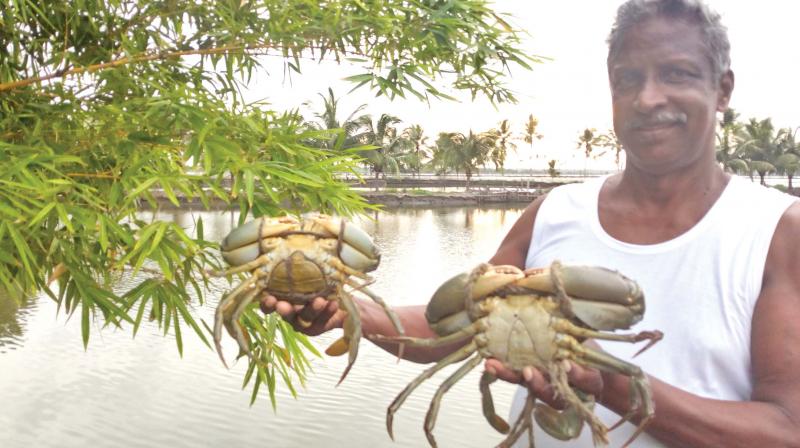Crabs fly high, rain gold on Kadamakkudi farmers
The demand for crabs goes up during the Chinese New Year (between January and February).

Kochi: The fishing fields of the picturesque Kadamakudy island in Ernakulam have turned a goldmine for the farmers. The live crustaceans organically cultivated in the Kadamakudy farms are in high demand in the seafood markets of Singapore, China, Malaysia and Taiwan.
“Crab farming has been done successfully in Kadakamakudy for several years and the farmers cultivate crustaceans in Pokkali fields, canals and backwaters. The mud crab variety is being exported from Ernakulam which is very expensive and high in demand. A kilogram of mud crab is priced at Rs.1,900,” said Shinoj Subrahmanian, principal scientist of Krishi Vigyan Kendra at Central Marine Fisheries Research Institute, the agency promoting organic rice and fish farming in Pokkali fields.
“The farmers have a good marketing strategy. The live crabs are being collected and exported every day, making the cultivation feasible. More than 600 metric tonnes of crabs is exported from the district with an annual turnover of Rs 60 crore,” he added.
The five months from December to April, when the salinity level in water is high, is the peak production season with an average daily output of 4,000 kilograms. At other times, the production will be 600 kg.
“Crabs are picked up and packed in bamboo baskets with a little water and sent to Chennai every day. From there they will be repacked and flown to foreign countries and the crustaceans will reach the export countries in 24 hours,” said John Kalluveetil, a crab farmer in Kadamakudy.
He sources crabs from local fishermen and the small crabs are transferred to the ponds. They will be reared and in one or two months they will be ready for export.
Crabs are exported in four different sizes--those with weights of 350 gm, 500 gm, 750 gm, one kilogram and more. Red crabs, which are a smaller variant, and female mud crabs are much sought-after in the Taiwanese market.
“Singapore is the main market for the mud crabs having a weight of one kg. Smaller mud crabs are also shipped to farms in Andhra Pradesh where they are then fattened for export,” he added.
The demand for crabs goes up during the Chinese New Year (between January and February). This is a win-win situation for crab farmers in Kerala as it coincides with the peak crab season in the state.
However, experts cite a few reasons which have affected cultivation of crabs in the state. “Small fishes like sardines and clay and trash fish are being widely used as crab meal. The scarcity of sardines has adversely impacted the manufacture of crab meal. Another challenge is deteriorating water quality in the backwaters, canals and ponds,” said Mr Subrahmanian.
“Since the traditional farmers in Kadamakudy have an efficient marketing strategy, the high-quality and big-sized crabs will never reach the domestic market. The farmers can sell even very small quantity like a single crab to the agents who will buy them from the specified collection points every morning. And the morning train from Ernakulam to Chennai regularly transports the live crabs,” added Mr Subrahmanian.
Most farmers in the area are involved in integrated fish-rice farming. During off seasons, the ponds in the farm are drained, tilled and cultivated with Pokkali rice. The CMFRI has been promoting Pokkali farming and assists farmers in marketing organic rice and fish products.

